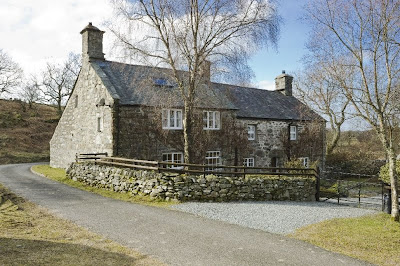 |
| This recent Royal Commission aerial photograph taken in April 2013 clearly shows the visible archaeology that is indicative of past habitation and farming. (Crown Copyright. RCAHMW, 2013). |
Royal Commission Investigators have just returned from a visit to explore the archaeology of Cardigan Island. The island lies just off the Ceredigion coast, adjacent to the estuary of the river Teifi and is owned by the Wildlife Trust of South and West Wales. Access to the island is restricted and we were very grateful to be given a place on the boat chartered for the annual egg count of the breeding sea birds and geese.
 |
| Landing on the Island. (Crown Copyright. RCAHMW, 2013) |
Landing on the island is tricky, and involved a rocky scramble onto the main grassland plateau which at this time of year is covered in extensive patches of bluebells. There are also clusters of tree mallow, not to mention the inhabitants, lots of nesting birds, particularly gulls and geese. It proved to be a noisy day!
Like many of the islands around the coast of Wales, a lack of modern development on Cardigan has preserved the archaeology and aerial photographs clearly indicate evidence of past habitation and farming. Much of the island is covered by ridge and furrow, indicating that at one time, most likely during the medieval period, arable farming was undertaken. However, the nature of these remains suggest this was never long established and it’s more likely that a pastoral economy predominated with the livestock watered by a number of small ponds in the centre of the island.
Two enclosed settlements, most likely later prehistoric in date, indicate that the island was also once settled. The smaller of the two enclosures contains evidence of five circular huts, whilst the much larger enclosure on the north side of the island, has one clear hut circle together with a large rectangular platform, possibly relating to a later phase of use. One unenclosed circular hut platform was also identified against which an earthwork bank dividing the whole island had been constructed.
 |
| The archaeology on the ground. GPS survey of the boundary bank dividing the island. (Crown Copyright. RCAHMW, 2013) |
The results of our field visit will now be collated into a survey report and the National Monuments Record enhanced with detailed descriptions and photography of the archaeology.
Article by Louise Barker, Head of
Recording and Investigation Team
Tanysgrifiwch i Newyddion Treftadaeth Cymru a chofrestrwch ar gyfer yr RSS porthiant llawn: cliciwch y botwm RSS hwn

a
thanysgrifiwch!
Rydym hefyd ar gael ar:



Twitter Hashtag: #RCAHMWales


 a thanysgrifiwch!
a thanysgrifiwch!




















